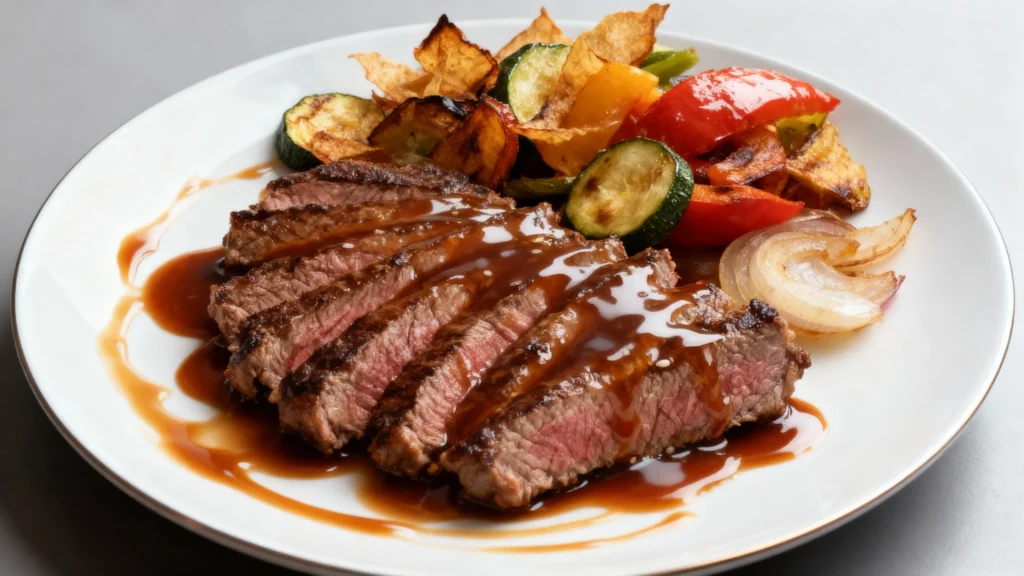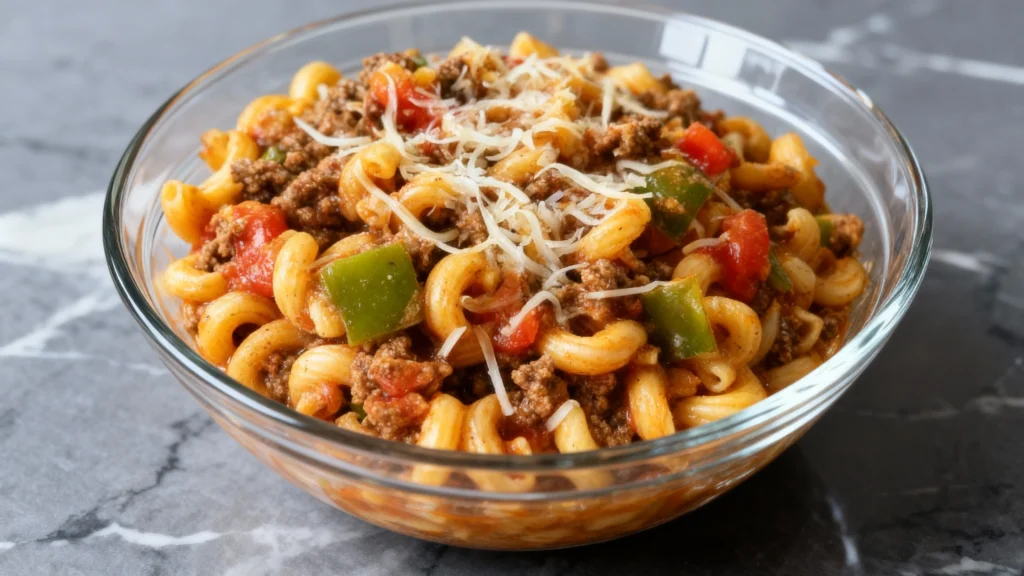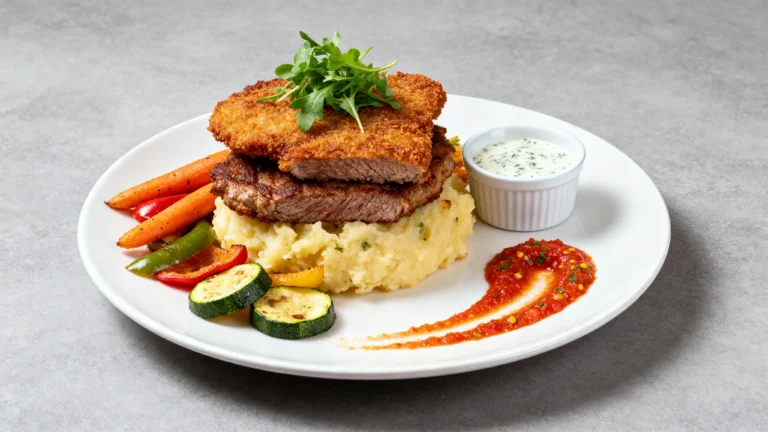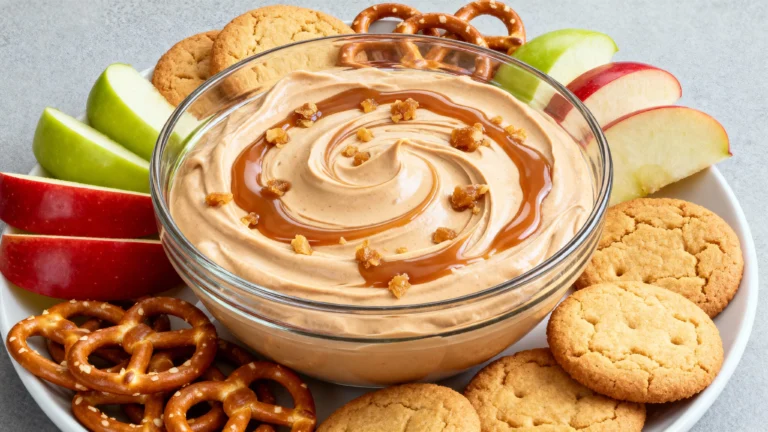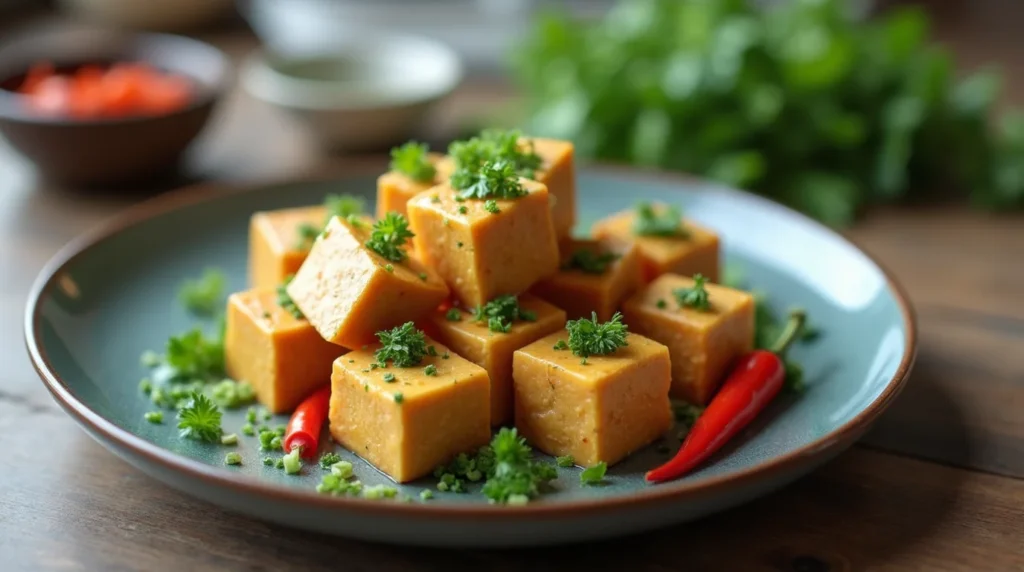
Easy Homemade Tauhu Recipe: Delicious Asian Tofu
Share this recipe
The smell of fresh tauhu (or tofu) would fill my family’s kitchen. It took me back to the lively markets of my childhood. This soft, silky ingredient is a big part of my culture. Now, I’m excited to share a simple tauhu recipe with you, so you can enjoy authentic Asian flavors at home.
Tauhu, or tofu, is a key ingredient in many Asian dishes. It’s found in Thai curries and Chinese stir-fries. Making it yourself saves money and lets you adjust the texture and taste. In this article, you’ll learn about tauhu’s origins, health benefits, and how to make it perfectly at home. Get ready for a tasty journey and enhance your meals with this versatile Asian ingredient.
Key Takeaways:
- Tauhu, or tofu, is a versatile and nutrient-rich ingredient in Asian cuisine
- Learning to make tauhu at home allows for customization and cost savings
- This recipe provides a simple, step-by-step guide to crafting delicious homemade tauhu
- Tauhu is a great source of plant-based protein and offers a variety of health benefits
- Experiment with different flavors and pairings to make tauhu a regular part of your healthy, balanced diet
Understanding Tauhu: Traditional Asian Tofu Explained
Tauhu, or tofu, is a key ingredient in Asian cooking for centuries. It started in ancient China and is now loved in many Asian cuisines, including Indonesian food. Learning about tauhu’s history, cultural value, and health benefits can deepen your appreciation for this important vegetarian protein.

Origins and Cultural Significance
The beginnings of tauhu are a bit of a mystery, but it’s thought to have begun in China during the Han Dynasty, over 2,000 years ago. It quickly became a mainstay in diets because it was a cheap source of protein. As time went on, how tauhu was made and used changed, showing the variety of Asian cultures and tastes.
Nutritional Benefits of Tauhu
Tauhu is packed with nutrients. As a soybean curd, it’s a top choice for those looking to eat more plant-based foods. It’s full of vegetarian protein, vitamins, and minerals like calcium, iron, and B vitamins. This makes it a great addition to soybean curd dishes for a healthy meal.
Different Types of Tauhu Available
- Firm Tauhu: This dense, sturdy variety is perfect for stir-fries, deep-frying, and braising dishes.
- Soft Tauhu: Delicate and creamy, soft tauhu is often used in soups, Indonesian food, and as a substitute for eggs in vegetarian recipes.
- Silken Tauhu: The smoothest and most delicate form of tauhu, silken tauhu is commonly used in desserts and dips.
Knowing the special qualities and uses of these different tauhu types can help you use it in many dishes.
Essential Ingredients for Perfect Tauhu Recipe
Making the perfect homemade tauhu, or Asian tofu, needs the right ingredients. Whether you’re an experienced cook or new to healthy plant-based cooking, knowing the key ingredients is important. Let’s explore the must-have ingredients for your next tauhu-making project.
Soybeans are at the core of any tauhu recipe. These versatile legumes give tauhu its creamy, silky texture. The quality and freshness of the soybeans greatly affect the final product. So, choose high-quality, non-GMO beans for the best results.
A coagulant is also crucial. It turns soy milk into solid tauhu. Traditional Asian recipes often use nigari (magnesium chloride), glucono delta-lactone, or calcium sulfate. Each coagulant gives a different texture and flavor. Try them out to find your favorite.
- Nigari (magnesium chloride) – Produces a firm, dense tauhu with a slightly salty taste.
- Glucono delta-lactone – Results in a silkier, more delicate tauhu texture.
- Calcium sulfate – Creates a slightly firmer tauhu with a more pronounced savory flavor.
You can also add salt, water, or seasonings to enhance your tauhu’s flavor and texture. These extras can help you achieve your desired taste and consistency. It makes your tauhu preparation a true culinary adventure.
“The secret to perfect tauhu lies in the quality of its ingredients and the care with which they are combined.”
By mastering the essential ingredients for tauhu, you’ll be well on your way to creating delicious, nutritious, and healthy plant-based dishes. Embrace the art of tauhu preparation and unlock a world of flavorful possibilities in your kitchen.
Kitchen Tools and Equipment You’ll Need
Preparing tofu at home is rewarding but needs the right tools. Whether you’re new to tofu or a pro at meatless meals, the right kitchen gear is key. It ensures your dishes turn out delicious.
Traditional vs Modern Preparation Tools
Old-school tofu making uses special tools like tofu presses and wooden molds. These tools help get the perfect texture and shape. But, modern kitchens have alternatives like silicone molds and electric presses. They make the process easier and more accessible.
Safety Equipment Considerations
- Sturdy cutting board: Make sure you have a strong, non-slip cutting surface for tofu prep.
- Sharp knives: Get a good chef’s knife or santoku knife for precise cuts.
- Heat-resistant gloves: Keep your hands safe from hot tofu or equipment.
- Splatter guard: Use a mesh or clear splatter guard to avoid oil splatters.
With the right tools and equipment, you’ll master tofu prep. You’ll create tasty meatless meals in your kitchen.
Step-by-Step Tauhu Recipe For Beginners
Making the perfect tauhu (Asian tofu) at home is an art. It requires patience and the right technique. This guide will help you make delicious homemade tauhu from scratch.
Start by soaking the soybeans overnight. This step is crucial for a smooth texture. After soaking, blend the soybeans into a fine puree.
- Strain the soaked soybeans and transfer them to a blender or food processor.
- Add water and blend on high speed until you achieve a smooth, lump-free consistency.
- Strain the soy milk through a fine-mesh sieve or cheesecloth to remove any remaining solids.
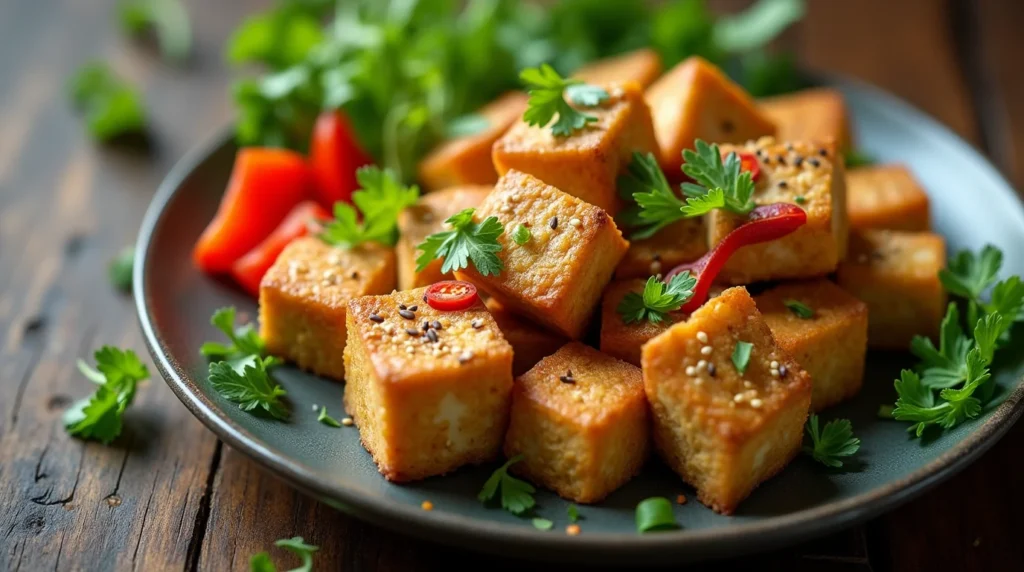
Next, coagulate the soy milk and shape the tauhu. You’ll need a coagulant like nigari or lemon juice for this.
- Gently heat the strained soy milk in a pot, being careful not to let it boil.
- Slowly add the coagulant, stirring constantly, until the curds begin to form.
- Carefully transfer the curds to a mold or tofu press and press to remove excess moisture.
Your homemade tauhu is now ready. It’s a versatile ingredient for many dishes. Enjoy it in tauhu pudding or savory stir-fries.
Mastering the Art of Tauhu Preparation
Making the perfect tauhu, or tofu, needs a mix of skill and care. As you learn more about tofu making, watch out for common mistakes. Also, use professional tips and techniques to make your homemade tauhu amazing.
Common Mistakes to Avoid
One big mistake is cooking tofu too long or too short. This can make it tough or crumbly. Also, not pressing and draining tofu well can add too much moisture. This messes up the texture and taste.
Professional Tips and Techniques
Experts say a few key things to make your tauhu prep stand out. These include:
- Slow and Gentle Cooking: Heat the soy milk and coagulant slowly. This makes the tofu softer and more delicate.
- Precise Pressing: Use a weighted press to get rid of extra moisture. This makes the tauhu firmer and more flavorful.
- Careful Handling: Handle the tofu gently to avoid it breaking or getting misshapen.
Temperature Control Guidelines
Keeping the right temperature is key for making great tauhu. The best temperature for coagulating soy milk is between 185°F and 195°F (85°C and 91°C). If it’s too hot, the tofu will be grainy. If it’s too cold, it won’t coagulate right.
By learning how to make tauhu, you can create tofu that looks good and tastes great. Use these tips and guidelines, and your homemade tauhu will wow everyone.
Flavor Variations and Seasoning Options
Preparing delicious vegetarian protein-rich soybean curd dishes is fun. Tauhu, a staple in Asian cuisine, can be made into many tasty dishes. This is done by trying different seasonings and marinades.
Adding herbs and spices can make your tauhu taste amazing. Try using garlic, ginger, scallions, or chili peppers for a bold flavor. Cumin, coriander, or five-spice powder can add a complex taste.
- Garlic and ginger: For a classic savory flavor
- Chili peppers: To add a spicy kick
- Cumin and coriander: For a warm, earthy undertone
- Five-spice powder: For a delightful blend of aromatics
Marinades can also make tauhu special. Combine soy sauce, rice vinegar, sesame oil, and a touch of honey or maple syrup. This creates a mix of sweet, sour, and umami flavors. Try different mixes to find your favorite.
“The beauty of tauhu lies in its versatility. With a little creativity, you can unlock a world of delicious possibilities.”
Whether you like bold flavors or something milder, you can make your tauhu just right. Be creative and try new things. This way, you can make your soybean curd dishes even better and enjoy every bite.

Serving Suggestions and Complementary Dishes
Tauhu, the versatile Asian tofu, is great for many dishes. It can make any meal better, from traditional Indonesian dishes to modern fusion dishes. Find the perfect pairings to highlight tauhu’s delicate flavors and textures.
Traditional Asian Pairings
In Asian cuisine, tauhu is a favorite. It goes well with fragrant spices, herbs, and bold sauces. Try it in gado-gado, a popular Indonesian salad, or moo shu tofu, a Cantonese stir-fry. Tauhu fits right into Asian culinary traditions.
Modern Fusion Combinations
Want to try new flavors? Explore meatless meals and Asian cuisine fusion with tauhu. It’s great with Mediterranean herbs and spices, like in a falafel. Or, mix it into a Indonesian food-inspired quinoa bowl for a tasty dish.
“Tauhu is a protein-rich ingredient that forms the foundation for a wide range of dishes, from classic Asian specialties to creative fusion recipes.”
No matter your taste, tauhu has endless possibilities. Try different flavors, textures, and cooking methods. You might find your new favorite tauhu dish.
Storage Tips and Shelf Life
Storing your homemade tofu preparation right is key to keeping it fresh. Here are some tips to make your healthy plant-based cooking stay delicious:
First, refrigerate your tauhu in an airtight container. This keeps it fresh for up to 5 days. Always eat it within this time for the best taste and safety.
Freezing is great for longer storage. Wrap it tightly in plastic or use a freezer-safe bag. This way, your tauhu can stay good for up to 3 months.
To thaw frozen tauhu, just leave it in the fridge overnight. Then, you’re all set to use it in your favorite healthy plant-based cooking dishes.
Watch for signs of spoilage like bad smells, color changes, or a slimy feel. If you see these, it’s time to throw it away to stay safe.

By storing your tofu preparation correctly, you can enjoy its taste for days or weeks. Happy cooking with your healthy plant-based cooking creations!
Health Benefits of Incorporating Tauhu into Your Diet
Tauhu, the versatile Asian tofu, is packed with nutritional benefits. It’s a great choice for vegetarians and anyone looking to eat more plant-based protein.
Tauhu is low in fat and cholesterol, making it good for your heart. Adding it to your diet can help keep your heart healthy and cholesterol levels in check.
Tauhu is also a good source of vitamins and minerals like calcium, iron, and magnesium. These nutrients are important for strong bones, healthy blood, and overall health. Including tauhu in your meals can help you get these essential nutrients.
“Tauhu is a versatile and nutritious addition to any diet, providing a valuable source of plant-based protein and essential nutrients.”
Tauhu is also very versatile and can be used in many tasty dishes. You can make stir-fries, curries, or even bake or grill it. The options are endless.
Whether you love tofu or are trying tauhu for the first time, it’s a great way to improve your health. It’s easy to add to your meals and can make a big difference in your well-being.
Conclusion
In this guide, you’ve learned about tauhu, a favorite in Asian cuisine. It’s packed with culinary and health benefits. You now know how to make it at home, adding it to your cooking.
With our tauhu recipe, you can make your own delicious version. You can customize the flavors and textures to suit your preferences. Use it in traditional dishes or try new recipes to explore its versatility.
Keep learning about tauhu as you cook with it. Remember to store it right and control its temperature. This guide has prepared you to improve your cooking, dive into Asian cuisine, and enjoy making your own tauhu.
Easy Homemade Tauhu Recipe: Delicious Asian Tofu
Enjoy the delicate, silky goodness of tauhu (Asian tofu) made fresh in your own kitchen. This simple yet flavorful recipe brings authentic Asian taste to your table. Whether stir-fried, braised, or added to soups, homemade tauhu is a healthy, protein-packed ingredient that fits into any meal.
Recipe Details
- Serving Size: 1
- Prep Time: 15 minutes
- Cook Time: 10 minutes
- Total Time: 25 minutes
Ingredients (Per Serving)
- 1 cup firm or extra-firm tauhu, cubed
- 2 tablespoons soy sauce
- 1 tablespoon rice vinegar
- 1 teaspoon sesame oil
- 1 clove garlic, minced
- 1 teaspoon grated ginger
- 1 tablespoon chopped scallions
- Salt and black pepper to taste
Nutritional Facts (Per Serving)
- Calories: 150 kcal
- Protein: 15g
- Carbohydrates: 8g
- Fat: 9g
- Fiber: 2g
- Sodium: 550mg
- Sugar: 2g
Instructions
- Prepare the Tofu: Drain the tauhu and gently pat it dry with a clean towel. Cut into 1-inch cubes.
- Make the Marinade: In a bowl, mix soy sauce, rice vinegar, sesame oil, garlic, and ginger. Add salt and pepper to taste.
- Marinate the Tofu: Toss tofu cubes in the marinade and let sit for at least 10 minutes.
- Cook the Tofu: Heat a non-stick skillet over medium heat. Add a little oil. Pan-fry tofu for 3–4 minutes per side until golden and crisp.
- Garnish and Serve: Sprinkle with chopped scallions. Serve with rice, noodles, or in a veggie bowl.


